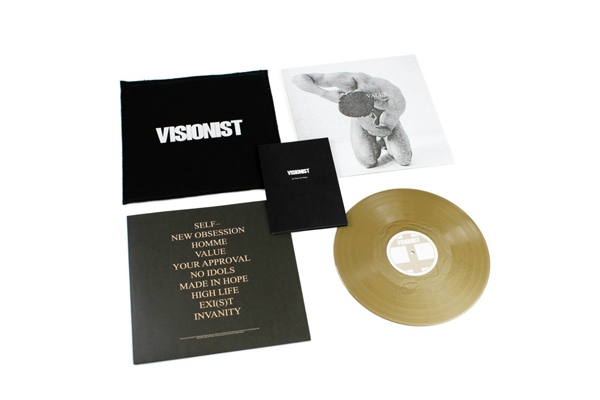 Photo by Toni Rosado.
Photo by Toni Rosado.
Imagine a centipede with powerful, scissor-like jaws, sheathed in iridescent armor. Now make that centipede nine feet long and infinitely more terrifying, and you’re getting close to envisioning the bobbit worm, a gorgeous nightmare-creature that spends its time buried in deep sea beds, until it senses its prey and attacks. The life of the bobbit worm—long periods of calm punctuated by startling moments of violence is a handy parallel for Value, the latest record by London experimental producer Louis Carnell, aka Visionist. Value’s spare sonics can be violently abrasive—the grinding rhythms on “New Obsession” suggests a bobbit worm decimating its prey—but they’re offset by shimmering synths and warm tendrils of piano. Value is at its most seductive when it’s pushing two conflicting elements together, and inventing ways for them to coexist.









Vinyl LP, Compact Disc (CD)




The videos and photographs designed to accompany Value’s 10 songs function as parallel explorations of the record’s conceptual concerns. Carnell sought out collaborators who could bring new dimensions to his work, creating multiple points of access into what can at times be a difficult record. Fashion designer William Francis Green, who handmade each of the limited-edition vinyl packages, didn’t want to make access too easy, though. He designed the frayed-edged black sleeve to be sewn shut around the golden LP inside. To access its contents, you have to take scissors to the pouch, essentially eliminating any resale value.
In other words, before even hearing Value, you’re forced to interrogate your own notions of worth. As Green puts it, “It fascinates me to see the fluctuation of a product’s worth—whether monetary or sentimental—over time. I really wanted to question that, and make the destruction of a piece really redefine its value to oneself.” The sleeve also works as a kind of “clothing” for Peter De Potter’s tender photographs of Carnell’s naked body that adorn the bonus photo ‘zine, jacket cover, and the sleeve’s inside flap, which can be cut into textile patches. (In other editions, the jacket is roughly the same color as Carnell’s skin.) De Potter, who is best known for designing the cover for Kanye West’s The Life of Pablo, emphasizes that the “minimal and brutal” images weren’t a translation of Value’s sound so much as a depiction of Carnell in relation to this new corpus of work. “All the poses show a certain tension and friction,” he says, “but not in the sense of an inner struggle. It’s not about introspection, rather about self-assurance and building yourself up.”
We encounter a multiplicity of Carnell’s again in Frederik Heyman’s video for the title track, which marries photogrammetry and digital art to recreate iconic scenes of rescue in which the artist is both victim and savior: “Louis saving Louis,” as Heyman puts it. Heyman loves the technique’s poignant stillness, which produces “a photographic moment frozen in a digital setting. In the video, Louis is in a deprivation tank, which brings him into the meditative state confronting himself.” Carnell had no issues with being so visible in his own work. “It’s my story, at the end of the day, and as an artist, I’m in control of how much I give of myself personally,” he says. “With my work being so much about my emotional trips, it is important for me to then put myself visually within all of that.”
For the video that accompanies “No Idols,” filmmaker Teri Varhol used her own photographs of nature as a tonal touchstone, while the record’s binary concerns—strength and vulnerability; machismo and effeminacy, etc.—unspool into dreamy shots of doppelgangers, shadow personae, and black and white figures in the woods. “[Value] goes to the core of the thing, definitely not somewhere ‘safe,’” she says. “I wanted that feeling to be reflected and emphasized in the video, creating tension for instance through uncertainty about whether some parts are mistakes and glitches or are deliberate,” she adds.
Varhol’s footage also appears in the Visionist live show, along with visuals from Berlin-based filmmaker Pedro Maia. According to Maia, the responsiveness and ephemerality of a live show makes it very different from creating a pre-edited work. Drawing from visual languages ranging from cinema to performance to experimental ceramics, the Visionist live show serves to summarize the album’s themes. “I re-work the live set according to the space, audience, and especially my mood and how I feel his music on that day,” Maia says.
As a whole, the new album has the same raw interiority that characterized Carnell’s 2015 debut Safe, an unflinching exploration of mental health. But on Value, there’s a different kind of vulnerability on view, one predicated on a loss of control and trust. “I like to have this back and forth with collaborators, where you both feel in control of the situation,” Carnell says. “They can take me into their world, because I’m already confident that it’s going to provide the right image and story.” On Value, he’s looking outwards for the first time, too, thinking about the intersecting pressures of the music industry. “We can be validated by the media rather than our audience. It’s almost quite easy to forget why you’re in music or why you have this practice,” he says, emphasizing that his newfound self-love is based on respect, not arrogance. “As long as I take that approach and continually feel like there’s something for me to learn within my work, that will drive me to keep creating.”







